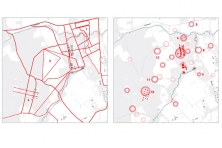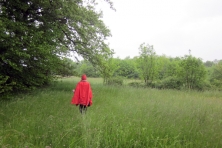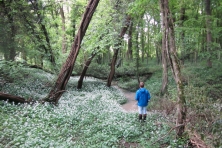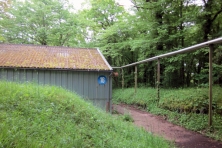Archipel de clairières, articuler des usages - composer des entités paysagères
Vichy Val d'Allier (FR) – Runner-up
TEAM DATA
Team Representative: Céline Frattesi-Bros (FR) – architect & urban planner; Associates: César Canet (FR), Laura Chavy (FR), Laetitia Paradis (FR) – architects
29 rue Bouret, 75019 Paris – France
+33 6 01 74 60 10 – lcaucarre@gmail.com – www.lcaucarre.com
See the complete listing of portraits here
See the site page here

L. Paradis, C. Canet, L. Chavy and C. Frattesi-Bros
INTERVIEW
1. How did you form the team for the competition?
Laetitia, Laura and Celine studied together at the ENSA Paris-Belleville School of Architecture. When Cesar suggested the idea of taking part to the competition to Celine, an ex-colleague at the AUA Paul Chemetov, she immediately thought to her former mates and the team was completed.
2. How do you define the main issue of your project, insisting on how you answered on this session main topic: adaptability and urban rhythms?
The site of Montpertuis-Palazol led us to two main issues: how to revitalize an industrial and military site, and, therefore, how to transform a forbidden area into a center of attractiveness.
To answer, we tried to anchor new uses and to federate an identity of the place, progressively and sustainably, while integrating the issues of time and evolution. To open the site and replace it in synergy with the territory, we relied on the potential and adaptability it contains. It is about investing in the landscape of clearings, and to reactivate the existing architectural forms (riffle range, earth barricade, and building 53). Lastly, the wood channel is considered as a programmatic frame all together flexible and structural. As a complete channel, it offers many possible orientations, such as formation, conception, production and research.

3. How did this issue and the questions raised by the site mutation meet?
Very soon the mutability appeared to be no longer an issue but a part of the answer. We developed the project right away considering the major (and minor) changes in time. At each scale (architectural, landscape and urban scale) adaptable proposals made a sustainable and consensual change.



4. Have you already treated this issue previously and could you present some reference projects that inspired yours?
The issue of architectural and urban adaptability inescapably crosses the various professional or research practices of each of us. The competition offered us a chance to truly question this issue. From many various references we indentified some major yet rather simple ideas for our project. For instance, with the project le plateau du Haye, Alexandre Chemetoff presents a process that tries to “assemble” in order to “draw a territory” that echoes our reflection on the opening and the synergy efforts of our site. At the architectural scale, the earth barricades appeared as an opportunity to play with the issue of the wall and the enclosure, like for instance the offices of the Junta de Castilla y León in Zamora of architect Campo Baeza. Finally, for the progressive deployment of a new and mixed program in a place for industrial memory, the Wesserling park appeared as a remarkable example.

5. Today –within the era of an economic crisis and sustainability– the urban-architectural project should reconsider its production method in time; how did you integrate this issue in your project?
We considered the process from several point of views. First, by thinking of a flexible phasing, based more on potential evolutions and events than on fixed dates. Then, we were willing to make landscape and architectural changes in a progressive and sustainable way. These processes aim at taking advantage of the existing potentials and logics with quite a low budget. The proposed answers, upgradeable yet structured, want to transform Montpertuis-Palazol in a more resilient place.
6. Is it the first time you have been awarded a prize at Europan? How could this help you in your professional career?
Oui, c'est une première pour nous quatre. C'est un résultat très stimulant qui récompense notre complémentarité et le travail de l'équipe. Nous souhaitons nous saisir de cette dynamique pour poursuivre nos parcours professionnels et entreprendre en tant qu'architectes.